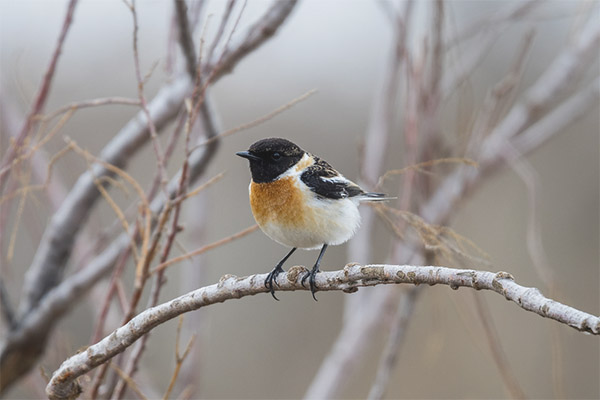The content of the article
By black-headed chase, we mean a feathery individual belonging to the thrush family. In terms of their dimensional features, these birds are slightly smaller when compared with house sparrows. Also, mobile and active chekana, the body grows up to 15 cm with a body weight of 20 grams. respectively. A distinctive feature of the type under discussion is the constantly twitching short tail and the habit of lowering the head to worship. But we will not get ahead of ourselves, studying the aspects in order.
Description
- According to its characteristics, it is somewhat similar to representatives of the meadow subspecies. Not too large, rounded in body format. Body length varies in the range of 12-15 cm with a mass of 12-20 g. Most of the life live in the bush thickets or tall grass. It has already been mentioned that a habit is considered to be the habit of pulling with a shortened tail and bowing to the head.
- In the European part of Russia, 3 subspecies of chekan are more common. In the western part, the chekans are classified as a subtype of rubicol, varigata is common in the Caucasus, and in the eastern side, the subspecies maura is the most common.
- Rubicola prefers to dwell in dry areas, sufficiently filled with light. Males by their external data are determined quite simply. They are characterized by whitish neck and chestnut chest. The head is black, allowing to separate this variety, for example, from meadow representatives. The females, as well as the young and individual males in the spring plumage differ from the sebe-like light zone above the tail and eyebrows of the same shade.
- Male representatives of the subspecies of Rubicol have a whitish collar and a black head. The thorax is pigmented with a bright red color, the area above the tail and the lumbar region are white with an ocher tone. The tail is completely painted black.
- Females of the same subtype are more pigmented red, but their upper part is dark, therefore, female individuals are partially similar to meadow representatives. A distinctive feature is the brow of a bright subtone,and the absence of bright spots in the side parts. There are light areas in the lumbar region, as well as above the tail. If you look from afar, it may seem that there is a whitish inclusion in this zone.
- Considering the subspecies of Maura, it is worth saying that the males are colored with contrast, rather than individuals of Rubicol. They are light in the abdominal part, above the tail and in the lumbar region. May be pure white, with a white necklace around and behind the neck. Maura females are also lighter than the rubicol subtype. They have a bright neck and chin.
- The subspecies of the varigat, including female and male sex, is similar to the Maura. But in the area of the wings there are white feathers. Juveniles of all three subtypes are similar to females, but they have more motley areas in the upper part of the head, wings and back. And in the lower section feathers with whitish patches. In autumn, all species are similar, dull and lighter.
Vote
- The singing of the individuals in question is somewhat reminiscent of broken phrases that can be heard with creaking trills. Such sounds are very similar to the exclamations of meadow chase.Only in the represented feathery voice sounds somewhat monotonous. In this case, you will not hear a clear gnashing.
- When black-headed chases are filled with songs, you will hardly hear the whistling sound elements in them. You can often hear that the individuals in question are peremeshne. Often the birds are engaged in singing on trees, pillars, tall bushes and even in flight. At the sight of danger, the birds begin to shout loudly.
Spread
- It is worth noting that in the European regions there are often several subspecies of the individuals under consideration. The same birds can be found in Africa and Asia. As for the territory of the Russian Federation, only 3 subspecies are common here.
- Blackheads often spread from the southernmost points of the country to the northern peaks. In such places, forest vegetation is already beginning to prevail. Also, individuals are very common in the southern tundra subzone.
- After wintering, the individuals in question return to their usual habitats in the midst of spring. Birds arrive precisely in the season of the appearance of greenery. In the northern areas, the coins are returned as soon as the last snow melts.
In many regions, such birds can be found in large numbers or moderate. If you look at the center of European Russia, in this area individuals are extremely rare. In the vast territories of the birds do not occur at all.
Video: Black Hex (Saxicola rubicola)












To send